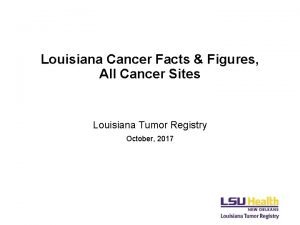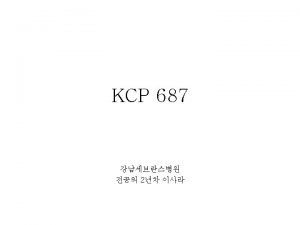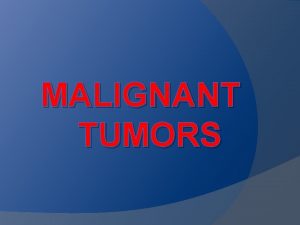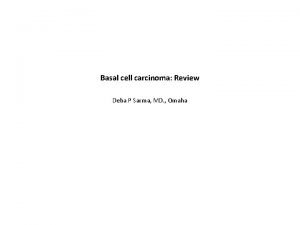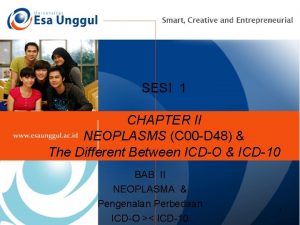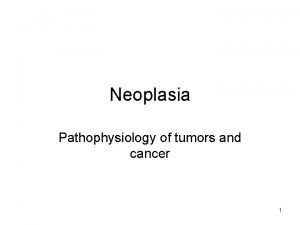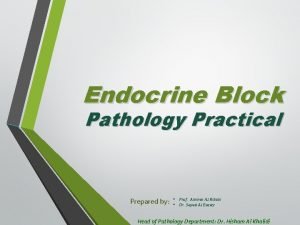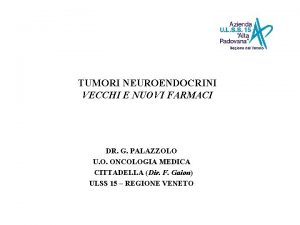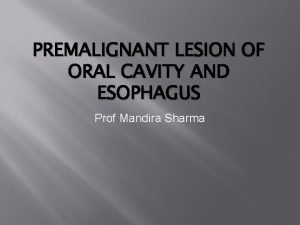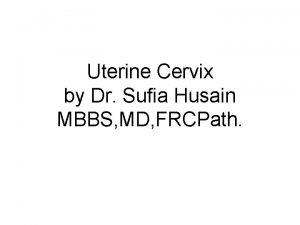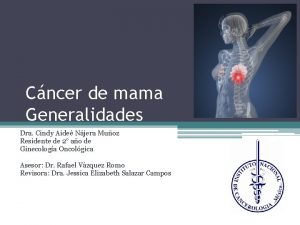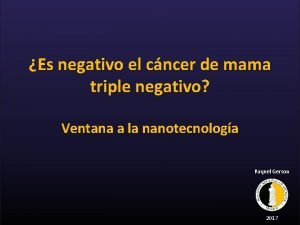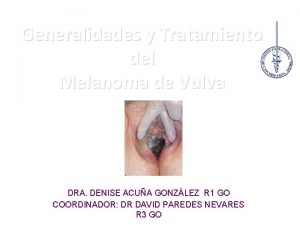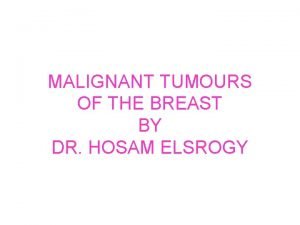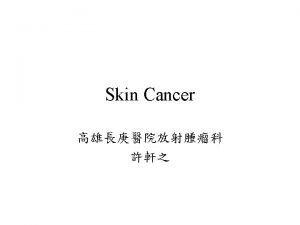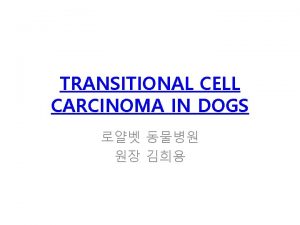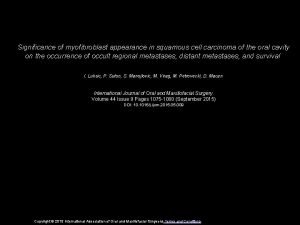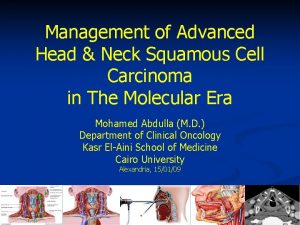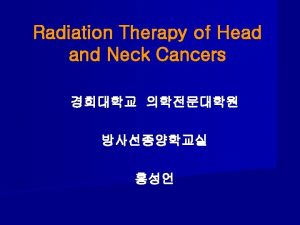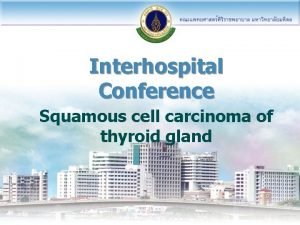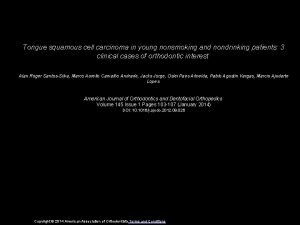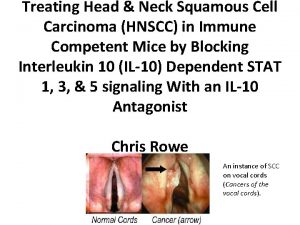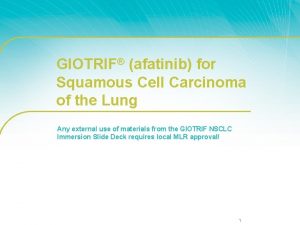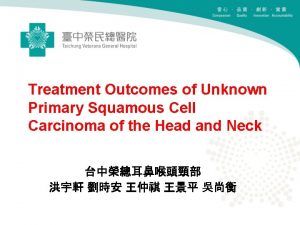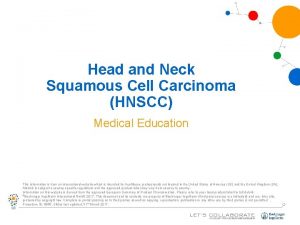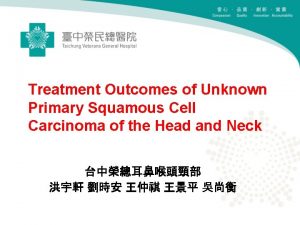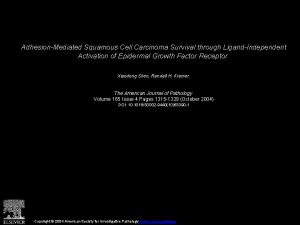Squamous cell carcinoma Sq CC of the lung



















- Slides: 19

Squamous cell carcinoma (Sq. CC) of the lung This information is from an international website which is intended for healthcare professionals not located in the United States of America (US) and the United Kingdom (UK). Afatinib is subject to country-specific regulations and the approved product label may vary from country to country. Information on this website is derived from the approved European Summary of Product Characteristics. Please refer to your local product label for full details. ©Boehringer Ingelheim International Gmb. H 2017. This document and its contents are property of Boehringer Ingelheim (third party sources are indicated) and are, inter alia, protected by copyright law. Complete or partial passing on to third parties as well as copying, reproduction, publication or any other use by third parties is not permitted. Procedure ID: 5955 Slides last updated: 14 th August 2017.

Sq. CC of the lung Epidemiology and risk factors Sq. CC, squamous cell carcinoma. This information is from an international website which is intended for healthcare professionals not located in the United States of America (US) and the United Kingdom (UK).

Lung cancer incidence • Lung and bronchial cancer has been the most common cancer in the world for decades 1 • In 2012, it was estimated there would be 1. 8 million new cases (12. 9% of all new cancer cases)1 • Lung cancer is the most common cancer in men worldwide 1 – The highest estimated age-standardised incidence rates in men are in Central and Eastern Europe (53. 5 per 100, 000) and Eastern Asia (50. 4 per 100, 000) – In women, the highest estimated agestandardised incidence rates are in North America (33. 8 per 100, 000) and Northern Europe (23. 7 per 100, 000) • Lung cancer is estimated to be responsible for nearly one in five deaths from cancer worldwide (1. 59 million deaths; 19. 4% of the total)1 This information is from an international website which is intended for healthcare professionals not located in the United States of America (US) and the United Kingdom (UK). 1. Globocan 2012. Estimated Cancer Incidence, Mortality and Prevalence Worldwide 2012. http: //globocan. iarc. fr/Pages/fact_sheets_cancer. aspx? cancer=lung. Accessed July 2017. 3

Lung cancer mortality and survival rates • Approximately 6. 5% of men and women will be diagnosed with lung and bronchus cancer at some point during their lifetime, based on 2011– 2013 US data 1 • Lung and bronchus cancer accounts for 13. 3% of all new cancer cases in the US 1 • In 2016, lung and bronchus cancer caused an estimated 26. 5% of all cancer-related deaths in the US 1 • The five-year survival rate is 17. 7%1 % cases by stage at diagnosis 5 -year relative survival by stage at diagnosis This information is from an international website which is intended for healthcare professionals not located in the United States of America (US) and the United Kingdom (UK). 1. Cancer Stat Facts: Lung and Bronchus Cancer. https: //seer. cancer. gov/statfacts/html/lungb. html. Accessed July 2017. 4

NSCLC subtypes: what is Sq. CC? • ~85% of lung cancers are NSCLC 1 • ~27– 46% of NSCLC cases in men and 11– 28% of NSCLC cases in women are Sq. CC 2 • diagnostic In recent decades, the predominant histologic shifted from Sq. CC to adenocarcinoma, in WHO Key histological featuressubtype of NSCLC histologic Clinicalhas features 3 particular in developed countries; one possible reason for this is increased use of low-tar filter cigarettes 3 categories of NSCLC* Adenocarcinoma Gland formation and papillary structures; IHC marker is thyroid transcription factor-1 3 Typically located peripherally; related to surface alveolar epithelium or bronchial mucosal glands. Most common histology in women 3 Sq. CC Characterized by areas of keratinization and the presence of intercellular bridges; IHC markers are p 63 and p 40, and possibly cytokeratin 5/63 Typically centrally located, making it more likely to invade larger blood vessels in the mediastinum, and more likely to cause bronchial obstruction. Begins in early versions of flat cells that line the inside of the lung airways and arises in the proximal bronchi. Commonly associated with tumour cavitation and a higher risk of pulmonary haemorrhage than adenocarcinoma. Stronger association with smoking than adenocarcnoma 3 NSCLC NOS No clear adenocarcinoma, squamous or neuroendocrine morphology or staining pattern. Classified as large cell carcinoma in resection specimens 4 Poor prognosis compared with other subtypes of NSCLC, even if diagnosed in the early stages of disease 5 NOS may also be diagnosed if the biopsy only contains a poor quality or little bronchial tissue, which lacks distinctive features 5 *by small biopsy and cytology. IHC, immunohistochemistry; NOS, not otherwise specified; NSCLC, non-small cell lung cancer; Sq. CC , squamous cell carcinoma. This information is from an international website which is intended for healthcare professionals not located in the United States of America (US) and the United Kingdom (UK). 1. Houston KA, et al. Lung Cancer 2014; 86: 22– 8; 2. Youlden DR, et al. J Thorac Oncol 2008; 3: 819– 31; 3. Socinski MA, et al. J Thorac Oncol 2016; 11: 1411– 22; 4. Travis WD, et al. J Thorac Oncol 2015; 10: 1243– 60; 5. Tane S, et al. Oncol Lett 2014; 8: 1017– 24. 5

Sq. CC of the lung: pathology • The characteristic morphological features of Sq. CC include flattened appearance, intercellular bridges, individual cell keratinisation and squamous pearl formation 1 A • Well-differentiated tumours show 1 – keratin pearl formation (A) – individual cell keratinisation and intercellular bridges evident at high power (B) • These are less obvious in poorly differentiated examples (C)1 B C Sq. CC, squamous cell carcinoma. This information is from an international website which is intended for healthcare professionals not located in the United States of America (US) and the United Kingdom (UK). 1. Davidson M, et al. J Thorac Dis 2013; 5(Suppl. 5): S 463 -S 478. 6

Sq. CC of the lung: the major risk factor is smoking • Sq. CC is associated more strongly with smoking than any other lung cancer 1 – In a pooled analysis (n=13, 169 cases and 16, 010 controls from Europe and Canada), the OR for Sq. CC in male current vs never smokers was 45. 6 (95% CI: 34. 3– 60. 6), compared with 10. 8 (95% CI 8. 7– 13. 3) for adenocarcinoma 2 • In patients with Sq. CC who are ever smokers, the estimated mortality rate is almost twice that reported in ever smokers with adenocarcnoma 3 CI, confidence interval; OR, odds ratio; Sq. CC, squamous cell carcinoma. This information is from an international website which is intended for healthcare professionals not located in the United States of America (US) and the United Kingdom (UK). 1. Derman BA, et al. Transl Lung Cancer Res 2015; 4(5): 524– 32; 2. Pesch B, et al. Int J Cancer 2012; 131: 1210– 19; 3. Lee PN and Forey BA. BMC Cancer 2013; 13: 189. 7

Sq. CC of the lung Clinical features, diagnosis and staging Sq. CC, squamous cell carcinoma. This information is from an international website which is intended for healthcare professionals not located in the United States of America (US) and the United Kingdom (UK).

Sq. CC of the lung: clinical presentation and symptoms • Patients with early-stage Sq. CC of the lung may have no obvious or defining symptoms¹ • As the disease progresses, the following symptoms might be observed¹ Symptoms may include: Persistent cough Coughing up blood Persistent chest infections Loss of appetite Unexplained weight loss Shortness of breath Ache when breathing Fatigue Hoarseness Discomfort when swallowing Finger clubbing Persistent chest or shoulder pain Sq. CC, squamous cell carcinoma. This information is from an international website which is intended for healthcare professionals not located in the United States of America (US) and the United Kingdom (UK). 1. NHS Choices: symptoms of lung cancer. http: //www. nhs. uk/Conditions/Cancer-of-the-lung/Pages/Symptoms. aspx. Accessed July 2017. 9

Sq. CC of the lung: diagnosis Medical history, imaging, pulmonary function 1 Biopsy and sampling 1 Medical history, including smoking history CT scan of chest and upper abdomen, with contrast FDG PET/CT scan Brain MRI with contrast MRI to establish whether disease has spread Pulmonary function tests Bronchoscopy Mediastinal lymph node evaluation Pathologic confirmation, e. g. via mediastinoscopy, thoracoscopy, needle biopsy, lymph node biopsy, mediastinotomy, EUS/EBUS biopsy Thoracentesis or pericardiocentesis CT, Computed tomography; EBUS, endobronchial ultrasound; EUS, endoscopic ultrasound; FDG, fluorodeoxyglucose; MRI, magnetic resonance imaging; PET, positron emission tomography; Sq. CC, squamous cell carcinoma. This information is from an international website which is intended for healthcare professionals not located in the United States of America (US) and the United Kingdom (UK). 1. NCCN Clinical Practice Guidelines in Oncology (NCCN Guidelines®): Non-small cell lung cancer. Version 8. 2017. https: //www. nccn. org/store/login. aspx? Return. URL=https: // www. nccn. org/professionals/physician_gls/pdf/nscl. pdf. Accessed July 2017. 10

Sq. CC of the lung: staging and TNM classification • The system used most often to stage lung cancer is the American Joint Committee on Cancer TNM system, which is based on 1 – The size of the main tumour (T) and whether it has grown into nearby areas – Whether the cancer has spread to nearby (regional) lymph nodes (N) – Whether the cancer has metastasised (M) to other organs of the body • Once the T, N, and M categories have been defined, this information is combined to assign an overall Stage of 0, I, III, or IV 1 • This process is called stage grouping 1 • It produces a range of anatomic stage or prognostic groups (right)1 M, metastasis; N, node; Sq. CC, squamous cell carcinoma; T, tumour. This information is from an international website which is intended for healthcare professionals not located in the United States of America (US) and the United Kingdom (UK). 1. American Joint Committee on Cancer. AJCC Lung Cancer Staging Poster 7 th ed. , 2009. https: //cancerstaging. org/referencestools/quickreferences/Documents/Lung. Medium. pdf. Accessed July 2017. 11

Sq. CC of the lung: TNM classification in more detail T Comments TX Primary tumour cannot be assessed, or tumour proven by the presence of malignant cells in sputum or bronchial washings but not visualised by imaging or bronchoscopy T 0 No evidence of primary tumour Tis Carcinoma in situ T 1 Tumour 3 cm or less in greatest dimension, surrounded by lung or visceral pleura, without bronchoscopic evidence of invasion more proximal than the lobar bronchus (for example, not in the main bronchus)* T 1 a Tumour 2 cm or less in greatest dimension T 1 b Tumour more than 2 cm but 3 cm or less in greatest dimension T 2 Tumour more than 3 cm but 7 cm or less or tumour with any of the following features (T 2 tumours with these features are classified T 2 a if 5 cm or less): involves main bronchus, 2 cm or more distal to the carina; invades visceral pleura (PL 1 or PL 2); associated with atelectasis or obstructive pneumonitis that extends to the hilar region but does not involve the entire lung T 2 a Tumour more than 3 cm but 5 cm or less in greatest dimension T 2 b Tumour more than 5 cm but 7 cm or less in greatest dimension T 3 Tumour more than 7 cm or one that directly invades any of the following: parietal pleural (PL 3), chest wall (including superior sulcus tumours), diaphragm, phrenic nerve, mediastinal pleura, parietal pericardium; or tumour in the main bronchus less than 2 cm distal to the carina* but without involvement of the carina; or associated atelectasis or obstructive pneumonitis of the entire lung or separate tumour nodule(s) in the same lobe T 4 Tumour of any size that invades any of the following: mediastinum, heart, great vessels, trachea, recurrent laryngeal nerve, oesophagus, vertebral body, carina, separate tumour *The uncommon superficial spreading tumour of any size with its invasive component limited to the bronchial wall, which may extend proximally to the main bronchus, is also classified as T 1 a. M, metastasis; N, node; Sq. CC, squamous cell carcinoma; T, tumour. This information is from an international website which is intended for healthcare professionals not located in the United States of America (US) and the United Kingdom (UK). 1. American Joint Committee on Cancer. AJCC Lung Cancer Staging Poster 7 th ed. , 2009. https: //cancerstaging. org/referencestools/quickreferences/Documents/Lung. Medium. pdf. Accessed July 2017. 12

Sq. CC of the lung: TNM classification in more detail N Comments NX Regional lymph nodes cannot be assessed N 0 No regional lymph node metastases N 1 Metastasis in ipsilateral peribronchial and/or ipsilateral hilar lymph nodes and intrapulmonary nodes, including involvement by direct extension N 2 Metastasis in ipsilateral mediastinal and/or subcarinal lymph node(s) N 3 Metastasis in contralateral mediastinal, contralateral hilar, ipsilateral or contralateral scalene, or supraclavicular lymph node(s) M Comments M 0 No distant metastasis M 1 Distant metastasis M 1 a Separate tumour nodule(s) in a contralateral lobe, tumour with pleural nodules or malignant pleural (or pericardial) effusion* M 1 b Distant metastasis (in extrathoracic organs) *Most pleural (and pericardial) effusions with lung cancer are due to tumour. In a few patients, however, multiple cytopathologic examinations of pleural (pericardial) fluid are negative for tumour, and the fluid is non-bloody and is not an exudate. Where these elements and clinical judgment dictate that the effusion is not related to the tumour, the effusion should be excluded as a staging element and the patient should be classified as M 0. M, metastasis; N, node; Sq. CC, squamous cell carcinoma; T, tumour. This information is from an international website which is intended for healthcare professionals not located in the United States of America (US) and the United Kingdom (UK). 1. American Joint Committee on Cancer. AJCC Lung Cancer Staging Poster 7 th ed. , 2009. https: //cancerstaging. org/referencestools/quickreferences/Documents/Lung. Medium. pdf. Accessed July 2017. 13

Sq. CC of the lung: genetic profile • Most Sq. CC lung tumours express: 1 – p 40/p 63 – Cytokeratins 5/6 – High molecular weight keratin – Carcinoembryonic antigen • Most Sq. CC lung tumours do not express cytokeratin 7 and TTF-11 • In the case of small biopsy specimens or poorly differentiated tumours that lack histologic signs of squamous differentiation, IHC staining for both p 40/p 63 (positive in Sq. CC) and TTF-1 (negative in Sq. CC) is often informative 1 IHC, immunohistochemistry; Sq. CC, squamous cell carcinoma; TTF-1, thyroid transcription factor-1. This information is from an international website which is intended for healthcare professionals not located in the United States of America (US) and the United Kingdom (UK). 1. Gerber DE, et al. Am Soc Clin Oncol Educ Book. 2014: e 353– 65. 14

Sq. CC of the lung is characterised by complex genomic alterations • Frequency of potentially targetable genetic abnormalities in Sq. CC of the lung include membrane receptor alterations, signalling pathway alterations, and transcription factor alterations • Patients whose tumours harbour specific molecular defects such as these may be enrolled in prospective clinical trials of relevant targeted agents • Potential targets include FGFR 1 amplification, alterations in the PI 3 K pathway, and DDR 2 mutations DDR, discoidin death receptor 2; FGFR 1, fibroblast growth factor receptor 1; PI 3 K, phosphatidyl 3 -kinases; Sq. CC, squamous cell carcinoma. This information is from an international website which is intended for healthcare professionals not located in the United States of America (US) and the United Kingdom (UK). 1. Perez-Moreno P, et al. Clin Cancer Res 2012; 18: 2443– 51. 15

Erb. B Receptor Family is a valid therapeutic target for Sq. CC of the lung • Dysregulation of the Erb. B pathway is frequently observed in Sq. CC of the lung 1, 2 Erb. B Receptor Frequency (%) EGFR overexpression 2 -5 26 -86 EGFR amplification 2, 5 15 -27 EGFRv. III mutation 6 5 EGFR kinase domain mutation 7 <5 ERBB 2 mutation/amplification 2 5 ERBB 3 mutation 8 1 ERBB 3 overexpression 9 10 ERBB 410 8 Frequency of known drivers in Sq. CC 11 ≈5% EGFR mutations 12 DDR, discoidin death receptor 2; EGFR, epidermal growth factor receptor; FGFR 1, fibroblast growth factor receptor 1; PI 3 K, phosphatidyl 3 -kinases; Sq. CC, squamous cell carcinoma. This information is from an international website which is intended for healthcare professionals not located in the United States of America (US) and the United Kingdom (UK). 1. Hirsch et al. J Clin Oncol 2003; 21: 3798 -807; 2. Lopez-Malpartida et al. Lung Cancer 2009; 65: 25 -33; 3. Lee et al. Lung Cancer 2010; 68: 375 -82; 4. Gately et al. Clin Lung Cancer 2014; 15: 58 -66; 5. Dacic et al. Am J Clin Pathol 2006; 125: 860 -5; 6. Ji et al. PNAS 2006; 103: 7817 -22; 7. Dearden et al. Ann Oncol 2013; 24: 2371– 76; 8. Jaiswal et al. Cancer Cell. 2013; 23: 603 -17; 9. Gorgoulis et al. Pathol Res Pract 1995; 191: 973 -81. 10. Kan et al. Nature 2010; 466: 869 -75; 11. Li et al. J Clin Oncol 2013; 31: 1039 -49; 12. Pao et al. Lancet Oncol 2011; 12: 175 -80. 16

Sq. CC of the lung Treatment options Sq. CC, squamous cell carcinoma. This information is from an international website which is intended for healthcare professionals not located in the United States of America (US) and the United Kingdom (UK).

Current treatment recommendations for metastatic Sq. CC of the lung (ESMO guidelines) PS 0 -2 Nivolumab (I, A; MCBS 5) Pembrolizumab if PD-L 1>1% (I, A; MCBS 3 if PD-L 1 >1%; MSBC 5 if PDL 1 > 50%) Docetaxel (I, B) Ramucirumab – docetaxel (I, B; MCBS 1) Erlotinib (II, C) Afatinib (II, C; MCBS 1) *ESMO guidelines do not recommend maintenance therapy in the treatment of squamous cell carcinoma NSCLC. BSC, best standard of care, EGFR, epidermal growth factor receptor; MCBS, Magnitude of Clinical Benefit Scale; NSCLC, non-small cell lung cancer; PD-L 1, programmed death-ligand 1; PS, performance status; Sq. CC, squamous cell carcinoma. This information is from an international website which is intended for healthcare professionals not located in the United States of America (US) and the United Kingdom (UK). 1. Novello S, et al. Ann Oncol 2016; 27(Suppl. 5): v 1–v 27. 18

Abbreviated EU Sm. PC EGFR M+ NSCLC and sq. NSCLC GIOTRIF®: Irreversible Erb. B family blocker. Active substance: Afatinib. Indications: GIOTRIF is indicated as monotherapy for (1) patients with locally advanced or metastatic NSCLC with activating EGFR mutations not previously treated with EGFR TKIs, (2) patients with NSCLC of squamous histology progressing on or after platinum-based chemotherapy. Posology: The recommended dose is 40 mg once daily, orally. Not recommended in patients with an e. GFR <15 ml/min and severe hepatic impairment. Contraindications: Hypersensitivity to afatinib or any of the excipients. Interactions: Potent P-gp inhibitors may lead to increased afatinib exposure, concomitant treatment with potent P-gp inducers may lead to a reduction in afatinib exposure. Afatinib is not an inhibitor or inducer of CYP enzymes. Undesirable effects: Paronychia, cystitis, decreased appetite, dehydration, hypokalaemia, dysgeusia, conjunctivitis, dry eye, epistaxis, rhinorrhoea, diarrhoea, stomatitis, nausea, vomiting, cheilitis, dyspepsia, alanine aminotransferase increased, aspartate aminotransferase increased, rash, acneiform dermatitis, pruritus, dry skin, palmar-plantar erythrodysaesthesia syndrome, nail disorders, Stevens-Johnson syndrome, toxic epidermal necrolysis, muscle spasms, renal impairment/renal failure, pyrexia, weight decreased, interstitial lung disease, keratitis, pancreatitis. Presentations: 20 mg, 30 mg, 40 mg, and 50 mg film-coated tablets. For detailed information, please refer to the published Prescribing Information. Supply classification: POM. This medicine is subject to additional monitoring. Boehringer Ingelheim International Gmb. H, Binger Strasse 173, 55216 Ingelheim am Rhein, Germany EGFR M+, epidermal growth factor receptor mutation positive; NSCLC, non-small cell lung cancer; TKI, tyrosine kinase inhibitor. Date of text revision: July 2017 19
 Hedgehog mites
Hedgehog mites Squamous cell carcinoma louisiana
Squamous cell carcinoma louisiana Anaplastic squamous cell
Anaplastic squamous cell Squamous cell carcinoma
Squamous cell carcinoma Non neoplastic epithelial disorders
Non neoplastic epithelial disorders Nodular melanoma
Nodular melanoma Basal cell carcinoma
Basal cell carcinoma Renal cell carcinoma
Renal cell carcinoma Kode icd 10 tumor leher
Kode icd 10 tumor leher Dysplastic squamous cell
Dysplastic squamous cell Enlarged thyroid gland
Enlarged thyroid gland Carcinoma squamoso polmone
Carcinoma squamoso polmone Esophagus
Esophagus Cin
Cin Carcinoma on scalp
Carcinoma on scalp Carcinoma micropapilar invasivo de mama
Carcinoma micropapilar invasivo de mama Carcinoma de mama
Carcinoma de mama Endocirne glands
Endocirne glands Ganglios linfaticos vulva
Ganglios linfaticos vulva Breast lump differential diagnosis
Breast lump differential diagnosis

